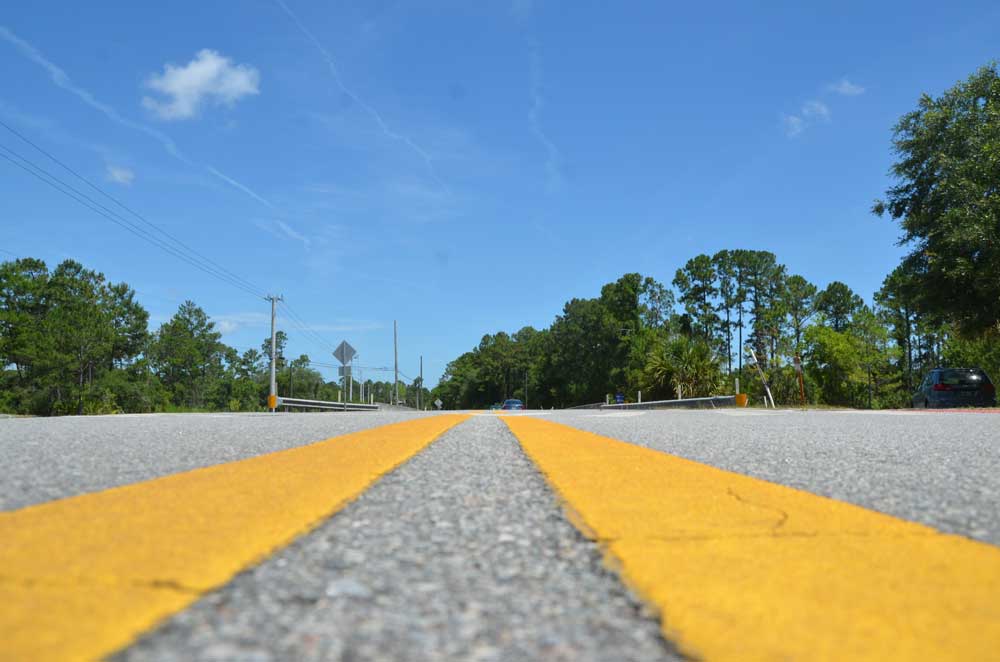
The Palm Coast City Council is not interested in spending $1.6 million to lower speed limits citywide from 30 to 25 mph–it would cost that much to change all the signs–and is leery about certain “traffic-calming” devices, whether speed “humps” or traffic islands.
But it will consider a plan that would leave it in residents’ hands to decide whether they want speed humps in their neighborhoods. Residents favoring such calming devices would have to muster majorities to convince the city that their neighborhood warrants humps. Those criteria would be applied citywide, even as the city’s fire chief cautioned against them.
“Anything that calms traffic calms emergency response,” Palm Coast Fire Chief Kyle Berryhill said. “So when we’re talking about traffic-calming options, we believe that speed limits and appropriate speeds are certainly best practice for safety.” Each traffic hump could delay a response by 10 seconds, multiplied over thousands of responses.
Sheriff Rick Staly said he was not opposed to the more elongated traffic humps that are gentler on vehicles (as opposed to traffic bumps), or to lowering speed limits. But he said any approach the city takes must be comprehensive. “It’s got to be a combination of traffic engineering, education and enforcement for it to be effective,” Staly said today. “One without the other is not going to have significant reduction. All it does is allow us to write more tickets or pull more people over.”
The city commissioned a traffic study for all its roads. The study was to look at whether speed limits should be lowered citywide, with a focus on Florida Park Drive and Cimmaron Drive. The urban speed limit set by law is 30 mph, with allowances for lower limits if justified.
The study took data from 48 speed zones and 109 locations. Of those, 17 speed zones met the condition for a 25 mph limit. The lowering of speed limits would have to be uniform. The city won;t lower them in some places and not in others.
Residential roads are those neighborhood roads in subdivisions without white and yellow paint. Fifty-one out of 67 such roads met the condition for a lower speed limit. Collector roads are the more heavily traveled neighborhood roads with yellow and white lines. Eight of 42 such roads met the condition for a lower speed limit.
The consultant presented three options: keep the 30 mph speed limit citywide and have a traffic-calming plan that would enable such things as speed humps or traffic islands if neighborhoods request them, though the rules to get there are not simple. The second option is to reduce speed limits on residential roads citywide to 25 and keep them at 30 for collector roads. But that would cost $1.6 million. Signs are that expensive.
The third option is to lower the speed limits and pay that cost, plus add traffic calming devices such as speed humps and a reduction of the lane width by narrowing the white lines a foot on each side, plus the sort of electronic signs that alert drivers when they’re speeding.
“If I’m looking at $1.6 million, or perhaps $1.6 million-plus in support of the sheriff,” Mayor David Alfin told Manny Rodriguez of Kimley-Horn, the engineering and planning consultant, “if we were to put that towards catching up with deputies, in terms of enforcement, it becomes a slightly different conversation than we’re having today. You’ve done your job, I get it. We have to look at the other side of it as well.”
Florida Park Drive is a collector road. The average speed there is 37, with an average of nine crashes per year. The study did not specify the severity of crashes. The study considered–but did not recommend–two traffic calming devices on Florida Park Drive, such as islands, each of which would cost $250,000. The islands typically do not reduce speeds by more than 2 o 3 miles per hour.
Traffic islands are effective over long stretches of road. “We look at Florida Park Drive,” Manny Rodriguez of Kimley-Horn, the engineering and planning consultant, said, “about 2-mile stretch, installing these two locations, it doesn’t seem to be worth it. We’re spending half a million dollars to reduce the speed three miles per hour maximum.”
Conditions warranting additional stop signs were not met. But the consultant is recommending speed humps for Florida Park Drive. The same findings apply to Cimmaron Drive. A majority of neighbors in proximity of the road where a speed hump would be installed would have to agree to one. In Ormond Beach, Alfin said, residents pay for the speed humps they want installed–and pay for the work when they want them removed. That could be a possibility in Palm Coast.
Seeing “a nuisance” in speed humps, at least to residents surrounding them, Council member Nick Klufas proposed a pilot program rather than a wholesale approach. “It’s evident that we don’t have speed humps on every road that we travel, and there’s a reason for that,” he said.
Cote said the traffic-calming plan would have to be developed first before the city could figure out where and at what cost speed humps would be installed.
“I’m more in favor of lowering the speed limit than I am for speed bumps,” Council member Ed Danko said.
For Council member Theresa Pontieri, she did not want Florida Park Drive and Cimmaron to “commandeer” the conversation. She wants the approach to take in the city as a whole. She favors a traffic-calming plan for the two roads, but based on criteria that would apply to other roads as well. She favors speed humps, as opposed to bumps.
“Yes, any second is crucial when you’re talking about saving a life, I agree. But when we’re looking at the bigger picture, lowering speed limits for people saves lives as well,” Pontieri said. “So I agree with Chief Berryhill, there’s a balance to strike. When I’m looking at the costs to lower speed limits of $1.5 or $1.6 million, as a rough estimate, I can’t justify that to my residents. I can’t do it, especially with all the other expenses that we have. The alternative is a speed hump,” which would cost about $7,500 per hump.
That means the more palatable $22,000 solution for Florida Park Drive than $1.6 million for a citywide lowering of limits. Pontieri said she would keep open the possibility of narrowing Florida Park Drive, but would oppose half-million-dollar traffic islands for the same reason she opposes lowering the speed limits.
Both Pontieri and Danko focused on enforcement. “We need more traffic enforcement of our speed limits on our residential roads,” Pontieri said. “This is not anything new. I’ve asked our sheriff’s office [about] this before and I want to be very clear. I think our sheriff’s office does a fantastic job keeping our community safe but traffic enforcement on our residential roads is so uber-important because we don’t have sidewalks, we have people on bikes, we have people walking, we have pets, kids, it is so crucial that we see an uptick in enforcement.”
Pontieri made a direct connection between the Sheriff’s Office requesting nine additional deputies for policing the city as part of a 20 percent increase in funding, and traffic enforcement. “We could kill two birds with one stone, get our deputies and see some stricter enforcement on our residential roads,” she said.
Staly pointed to the 130 percent increase in traffic enforcement since he took over as sheriff in 2017, and a misperception about speeding and traffic problems. “Many times, not all times, we find that it is perception and not reality,” the sheriff said. “What we do whenever we get a traffic complaint that comes in, we have the cameras we’ll put up, it will track the speed and the date and time, so we can get an average speed, we can then find out what is the best time to do traffic enforcement to have an impact, because just having a deputy sit on a street for six hours is not a good use of resources.”
It isn’t only traffic deputies who conduct traffic enforcement. Every patrol car now has radar and every deputy has been sent to 40-hour radar enforcement class, Staly said. He also cautioned about worsening traffic ahead, as thousands of new residents continue to move in–a projected 40,000 more over the next 11 years.
“My hope is that the city does not set the expectations so high that just lowering the speed limit is the solution, because it’s not,” he said, addressing one of the options. His team is studying the city’s traffic report before issuing its own conclusions.
“It’s really a matter of ROI, return on investment, in terms of how much we spend to get a certain result,” Alfin said. “It’s clear, there’s no perfect solution other than if we have perfect drivers, and then even then we probably have some issues. But we’ll do as best we can with the resources that we prioritize in the budget to make it better than it is today.”
![]()
palm-coast-speed-study




